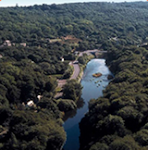Two errors on my part that I need to correct with thanks to the readers that pointed them out.
In "Bridge of Delights" I included a photograph of Flowering rush. Unfortunately I misinterpreted this as a rush in flower, not quite the same thing. Flowering rush (Butomus umbellatus), despite its common name, is not a member of the rush family.
In "A baker's dozen of butterfly species" in the report of our visit to Dothill I misidentified the photograph of a Meadow brown as a Gatekeeper.
Both blogs have been updated to correct these errors.
Blackbridge Quarry, Wednesday 10th August 2016
Shropshire Wildlife Trust kindly gave us permission to visit this quarry which is sandwiched between Pant and Llynclys Hill. You are unlikely to stumble across it as it is no more than a hole in the ground in woodland, shielded from unsuspecting eyes on the lane that passes it by the trees. The entrance is easy to miss being a narrow descent into the gloom.
When you do find the entrance you have to negotiate a wire fence, a steep, sometimes slippy, descent down some soil steps and then the gate.

The gate is locked.
Fortunately we had a key.
And it worked.
For the sake of accuracy I must point out that the photograph of the gate was taken from the other side after we had passed through it.
The quarry is in two parts and the flora is different in the two with a marked change as you pass from one to the other.
The first part which opens out in front of you when you have finally managed to get in is more rocky and sparsely vegetated in the open area with a dark and dingy section at the far side in the shadow of the quarry face.



Marjoram was common sight in this area

The second part was more of a grassland but still with scrubby areas against the quarry face.


We spent our day wandering around these two areas looking at whatever caught our interest.
That was it.
There is not much more to relate really other than we gathered around a convenient rocky ledge for lunch. Nothing of note happened that is worth reporting and there was the usual chatter about cameras.
There was high excitement at the end of the day, which I will get to later.
But what did we see?
Once again my colleagues have come to my rescue and provided lots of photographs which my camera failed to take. So a picture section follows to give you a flavour of our observations.

Six-spot burnet.

Common earwig.

Harebell.

Ploughman's spikenard.

Epistophe grossulariae.

Eristalis interruptus (also known as Eristalis nemorum). An excellent photograph capturing the courtship behaviour of a male as it hovers over a female trying to attract her attention and mate.

Helophilus pendulus.

Homo sapiens.

More Homo sapiens.

Knapweed.

Honey bee.

A teneral (freshly emerged) Sloe bug also know as a Hairy shieldbug.

An older Sloe bug.

Leucozona glaucia.

Meadow brown.

Pardosa species, probably Pardosa saltans.
So after we spent several happy hours exploring this wonderful site we prepared to leave. But someone had noticed another hole in the ground by the gate. This was actually a hole in the quarry face. A man-made cave? If it was a cave would there be cave spiders present?
Unfortunately the entrance to the "cave" was covered by a grill and it was locked so we could not get in.

This did not stop us. A powerful torch was produced and its beam caught sight of a cave spider which promptly scuttled off to hide from the light that was intruding into its life. However the characteristic egg sacs suspended from the roof remained and were duly photographed.

So high excitement at the end of the day.
Thank you to Stephen Mitchell, Jim Cresswell and Bob Kemp for supplying many of the photographs in this report. Thank you to Shropshire Wildlife Trust for giving us access. An excellent site. An excellent day.














































